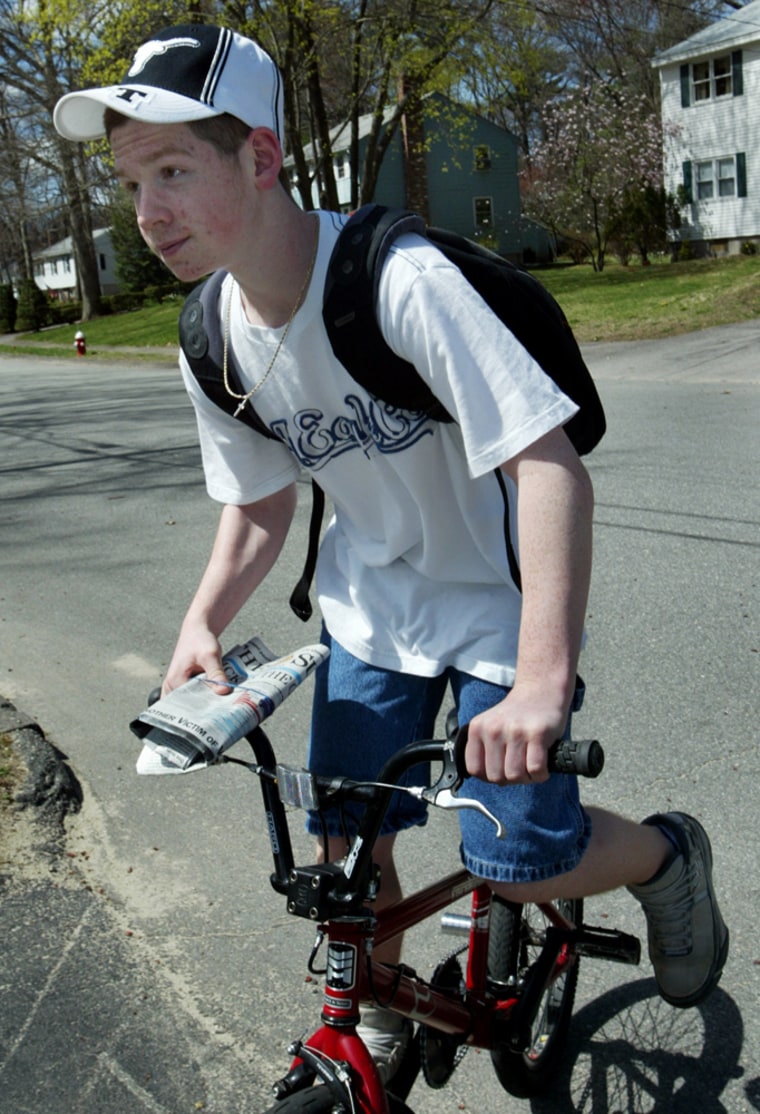A young teen riding his bike at dawn reaches into his shoulder bag, grabs a tightly folded newspaper and deftly throws it to the front steps.
It’s an image as American as apple pie, but the paperboy has gone the way of the milkman.
Today’s papers usually arrive by anonymous drive-and-toss. For reasons including the demise of afternoon papers, a shift to centralized distribution and earlier delivery deadlines, adults in cars now make up 81 percent of the country’s newspaper carriers.
“I don’t know who delivers my papers,” said Stacey Rufe of Glen Allen, Va., lamenting the disconnect she has with her Washington Post carrier. “When I was growing up, our carrier was my friend Mike and his brothers. If you had a problem, you called Mike.”
As recently as 1994, more than half of newspaper carriers — 57 percent — were under 18, often neighborhood kids, according to the Newspaper Association of America.
As the job moved into the hands of grown-up independent contractors, who don’t come to the door for payment anymore, many bemoan the lost sense of community in which the paperboy played a unique role. Also lost is an opportunity that gave children as young as 10 business skills.
Rite of childhood
If you weren’t a paperboy or girl, your sibling, parent or friend was. And if you didn’t do it, you subbed for your brother when he went to scout camp. Parents, more likely than not, helped — either driving on bad weather days or helping stuff inserts into the Sunday papers.
Some former paperboys recall loving the responsibility and sense of pride; others hated the early mornings and collecting from stingy subscribers.
“It was a great first job because I had to manage for myself,” said George Rohling, 41, who delivered The (Spokane, Wash.) Spokesman-Review in the 1970s. Like most paperboys, Rohling was paid according to how many papers he delivered, and he collected payments each week. “I wasn’t standing at a register, asking if they want fries.”
President Truman, actors John Wayne and Bob Hope, and baseball star Willie Mays all had paper routes when they were young. So did TV journalist Tom Brokaw, cartoon great Walt Disney and investment whiz Warren Buffett.
Teens and tweens really started delivering America’s papers in the postwar era, NAA Vice President John Murray said. Boys had hawked newspapers on city street corners, and as customers moved to the suburbs, it was a natural fit.
“They were appealing, tenacious and would work in a small window of time,” Murray said. In return, delivering papers rewarded kids “relatively speaking, handsomely.”
More than a job
In the 1950s, Henry Petroski earned the then-lucrative sum of $20 a week delivering the Long Island Press each afternoon and Sunday morning. The job taught him how to deal with people and money, as well as how to fold a paper.
“It wasn’t that easy; the first few times the paper would open in the air and would fall apart,” said Petroski, now a Duke University professor and author of a memoir, “Paperboy: Confessions of a Future Engineer.”
“By learning what didn’t work, you learn eventually what not to do more than the secret of doing it right.”
Now Petroski receives his Durham Herald-Sun each day from an adult driving a car. It’s not the same, particularly when it rains.
“When I was a paperboy we would what we called ’doorknob,”’ he said. “You would walk up to the door and put the paper in the storm door. Here, it’s just a yellow plastic bag at the bottom of the driveway.”
You missed — whoever you are
Rufe, 34, never knows where to expect her paper, or even what paper she’ll get.
“Today (the paper) was on the bottom of our steps, usually it’s on the driveway, sometimes it’s in the paper box,” said the part-time lawyer. She said she’s received The Financial Times, The New York Times and The Korean Times, many times in lieu of her preferred Post.
Yes, she can call the Post to complain, but “If I knew who my carrier was, I could call him,” she said.
At least one paper is bucking the trend. Since December 2005, The Sun in Lowell, Mass., has shifted about 2,000 papers from adult routes back to youth carriers.
“It’s strengthening everything all the way around,” Circulation Vice President Michael Sheehan said. Routes grow future newspaper readers, he said, while young carriers provide better service and create customer loyalty. Sun paperboy Joseph “JJ” Polcari, 15, is learning about the value of good service. A five-year veteran of delivering Sun papers, he was recently named carrier of the week.
“If you treat people well, they give you good tips,” said Polcari, who earns about $40 a week. Delivering 20 papers takes only 20 minutes each day, he said, thanks to his bike.
And the work is paying off: His mother, Debbie, said J.J. is saving for a car and already has enough for insurance.
Yet this return to youth carriers is an alternative not open to many morning papers. In Bloomington, Ill., The Pantagraph employs about 200 young people in its carrier force of 480. Circulation director Bill Hertter says it’s tough these days to find teens willing to deliver the morning paper by 6 a.m. every day.
“Money is too available,” he said. “Why would they want another five, 10 bucks when they have everything?”
